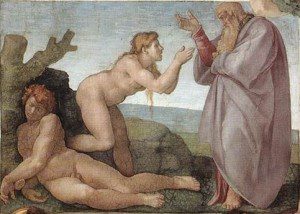With consideration of Genesis 2 the series of posts on Genesis intersects those on biblical womanhood.
 Genesis 2 provides a creation account both distinct from an complementary to the creation account of Genesis 1. In both accounts the culmination of creation is human beings, male and female, placed in God’s sacred space to be his image – a royal priesthood tending his garden. There are many aspects of Genesis 2 that could be used to shape this post. The difference in the order of creation and the impact this should have on our understanding of the creation accounts in scripture. The importance of the garden as a royal space next to the king’s palace. The significance of the named rivers and the trees. These are all important and have all come up in posts in the past. Today, however, I would like to focus on man and woman, male and female.
Genesis 2 provides a creation account both distinct from an complementary to the creation account of Genesis 1. In both accounts the culmination of creation is human beings, male and female, placed in God’s sacred space to be his image – a royal priesthood tending his garden. There are many aspects of Genesis 2 that could be used to shape this post. The difference in the order of creation and the impact this should have on our understanding of the creation accounts in scripture. The importance of the garden as a royal space next to the king’s palace. The significance of the named rivers and the trees. These are all important and have all come up in posts in the past. Today, however, I would like to focus on man and woman, male and female.
All three of the commentaries shaping this series on Genesis (Tremper Longman III, Genesis in the Story of God Bible Commentary, John Walton, The NIV Application Commentary Genesis and Bill Arnold, Genesis (New Cambridge Bible Commentary)) comment explicitly on the nature of humankind as male and female and its significance in the creation account. The first point, on which all three authors would agree, we need to avoid reading modern questions and answers back into Genesis 2, expecting it to address questions that were not important to an ancient audience. Our current questions about complementarian or egalitarian relationships, and more significantly about women in ministry, simply weren’t the burning questions for the original author or audience. Genesis 2 has much to say about the partnership between a man and a woman, but little to say about the other issues.
First, the text:
Genesis 1:26-28 notes the creation of humankind with a purpose and a mission. There is no distinction, just a recognition of male and female. “So God created humankind in his image, in the image of God he created them; male and female he created them.“
Genesis 2 goes into more detail about the relationship between male and female.
The Lord God said, “It is not good for the man to be alone. I will make a helper suitable for him.”
…
But for Adam no suitable helper was found. So the Lord God caused the man to fall into a deep sleep; and while he was sleeping, he took one of the man’s ribs and then closed up the place with flesh. Then the Lord God made a woman from the rib he had taken out of the man, and he brought her to the man. The man said, “This is now bone of my bones and flesh of my flesh; she shall be called ‘woman,’ for she was taken out of man.” That is why a man leaves his father and mother and is united to his wife, and they become one flesh. (v. 18-24)
The word play in English woman from man is also present in the Hebrew, the ishshah was taken out of the ish. The point is that the women belongs to the same category as the man – they are human beings. Much has been made of the word translated “helper” in v. 18 and 20. The NRSV translates suitable helper as “a helper as his partner.” The intent is not to establish a hierarchy but to establish a partnership. Arnold, Longman, and Walton all agree on this point.
Bill Arnold comments:
The phrase itself, “a helper as his partner” occurs only here in the Bible. The compound preposition kĕnegdô implies complementarity (hence the NRSV’s “as his partner”), so the need is for someone “corresponding to him” as his counterpart. While in English the term, “helper” may imply subordinate or inferior rank, this is not the case in Hebrew. Various uses of the verb ‘zr, “help, support” refer to God’s help for humans or of military help, and the noun ‘ēzer, “help(er)” can likewise be used of God. In such cases there is no hint of inferiority or subservience. … Indeed, this story of human origins may be related to the lives of ordinary women in the highland villages of early Israel, whose societal and household roles may be reconstructed on the basis of archaeological and anthropological parallels. Prior to the monarchy, the subsistence work of families required the interdependence of men and women to perform the tasks facing families, such as clearing the rocky land for agriculture and producing children to help with the farming. At this early stage of Israelite thought, egalitarian views of the roles of men and women were God-given and unquestioned. (p. 60)
Tremper Longman makes a similar point on the word ezer.
Some people believe that a “helper” implies subordination, but nothing could be further from the truth. The Hebrew word “helper” (ezer) is not equivalent to the English word “valet.” How do we know this? The psalms frequently refer to God as Israel’s helper (Pss 33:30, 89:18-19; see also Deut. 33:39), and, of course, God is not Israel’s valet. In military contexts, the word ezer is translated “ally.” Indeed, since we will see that there are threats to the garden (the serpent), ally may work for this context as well. This ally is “suitable to” or “corresponding to” him. The emphasis is on equality throughout the description of the woman in Genesis 2. (p. 50)
John Walton digs into the Hebrew a bit more completely in his commentary and in doing so gives more appreciation for the difficulties inherent in translating an ancient text in a “dead” language. However, he comes to a similar conclusion. Walton points out that Adam finding companionship with a woman runs counter to trends in Mesopotamian literature. In the Gilgamesh Epic, Enkidu find animal companionship satisfactory until he is seduced by a prostitute. How different the picture in Genesis 2! With respect to “a helper suitable for him” Walton points out that “nothing suggests a subservient status of the one helping; in fact the opposite is more likely. Certainly “helper” cannot be understood as the opposite/complement of “leader.”” (p. 176) His reasons are similar to those provided by Arnold and Longman. Elsewhere the word is used with God as the subject or in the context of military alliances. Concerning the phrase translated in the NIV as “a helper suitable for him,” Walton concludes “I would choose a translation such as “partner” or “counterpart.” The former better reflects the “helper” part of the combination, while the latter better reflects the compound word. If we could make up words, “counterpartner” would be a great one.” (p. 177)
Others have suggested that in the Genesis 2 story, the original man was not male, but simply human, an earthling. Male and female are two parts of one whole. Iain Provan in Seriously Dangerous Religion notes “The special place of human beings in the cosmos is in this way underscored. Only another image bearer will suffice as a partner for ’adam…. And so the earthling is divided and becomes male and female.” (p. 89)
 Marriage as partnership. The institution of marriage is important to this idea of woman as the ally and counterpartner of man. Arnold comments “Thus marriage is not simply about romance or raising a family, but about reuniting tow parts of a sexual whole. The mysterious power driving the sexes together is explained in the common fleshly bond they had in the primordial communal unity of the first two humans, which becomes a paradigm for all marriages.” (p. 61) Whereas in a patriarchal society the woman leaves and joins the man’s family, the emphasis in Genesis 2 is on the man leaving father and mother and becoming one with his wife. That both leave and join together is an important part of the partnership envisioned. The only time Jesus refers to the creation story it is to highlight the importance of marriage and the alliance between man and woman. Polygamy, divorce and the like are accommodated at times, but were never God’s ideal plan (e.g. Matt 19:3-11).
Marriage as partnership. The institution of marriage is important to this idea of woman as the ally and counterpartner of man. Arnold comments “Thus marriage is not simply about romance or raising a family, but about reuniting tow parts of a sexual whole. The mysterious power driving the sexes together is explained in the common fleshly bond they had in the primordial communal unity of the first two humans, which becomes a paradigm for all marriages.” (p. 61) Whereas in a patriarchal society the woman leaves and joins the man’s family, the emphasis in Genesis 2 is on the man leaving father and mother and becoming one with his wife. That both leave and join together is an important part of the partnership envisioned. The only time Jesus refers to the creation story it is to highlight the importance of marriage and the alliance between man and woman. Polygamy, divorce and the like are accommodated at times, but were never God’s ideal plan (e.g. Matt 19:3-11).
John Walton elaborates on the function of marriage, agreeing with Arnold. Reproduction is an important part of the human mission, but is not the sole purpose of marriage and it is not the purpose of woman, as though the man would otherwise be fine alone or in the company of animals.
At the same time, the text does not suggest that woman was created merely to be a reproduction partner. It is one of her functions (the text is providing for reproduction), but it is not her purpose. Adam was not looking among the animals for something to reproduce by. Yet he was looking for something, since the texts says that what he was searching for was not found (v. 20). His identification of Eve as his counterpart in verse 23 suggests that she was the counterpart for which he was searching.
When Adam identified the roles and functions of each of the animals, he realized that none could serve as a partner in the functions that he was serving, – functions related to the blessing from 1:28-29 as elaborated in chapter 2, namely, subduing and ruling (1:28, i.e., extending the garden), serving and preserving the garden (2:15), and being fruitful and multiplying (1:28). Woman becomes his partner in all of these functions. Only such a “counterpartner” could serve the function of reproduction partner, but reproduction is not thereby the purpose of the counterpartner. (p. 187-188)
The ultimate purpose for marriage as a partnership between man and woman to serve as God’s images in the world is fulfilled whether children result or not. Longman agrees. “Significantly, marriage is not here defined as including childbearing as an essential part. … Of course, the Bible delights in children; they are a gift from God (Ps 127:3-5), but they are not part of the divine definition of marriage.” (p. 55) And this means that sexual intimacy in marriage is a gift to be enjoyed, whether it can result in children or not.
Nothing in this passage signifies hierarchy or male headship in marriage. The passage doesn’t address other contexts or issues.
What is the significance of woman as a suitable partner or “counterpartner?”
What is the purpose of woman in this passage?
What is the purpose of marriage?
If you wish to contact me directly you may do so at rjs4mail[at]att.net.
If interested you can subscribe to a full text feed of my posts at Musings on Science and Theology.
















